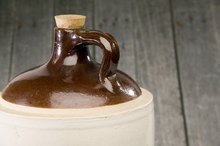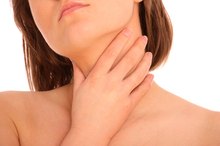I Have Severe Abdominal Pain That Goes Away After Eating
Severe abdominal pain that’s alleviated when you eat is most likely the result of an ulcer. The most common symptom of an ulcer is abdominal pain, according to MayoClinic.com 2. The pain may get worse when your stomach is empty because the exposed portions of your digestive tract are exposed to stomach acids and chemicals that cause irritation. If you suspect that you have an ulcer, talk with your doctor for a clinical diagnosis. Most ulcers are treated with prescribed medications and lifestyle changes, such as quitting smoking and eliminating alcohol consumption.
If you are experiencing serious medical symptoms, seek emergency treatment immediately.
Definition
Peptic ulcers are sores that develop in the soft tissue that lines the opening of your small intestines, stomach or esophagus. The University of Maryland Medical Center states that an estimated 20 million people in the United States will develop an ulcer in their lifetime 1. Most ulcers are caused by a bacterial infection. It is unclear how the infection is spread, but it is suspected that hand washing and proper hygiene may reduce your chances of getting the infection. Some ulcers are caused by lifestyle choices or gastrointestinal surgery.
- Peptic ulcers are sores that develop in the soft tissue that lines the opening of your small intestines, stomach or esophagus.
- It is unclear how the infection is spread, but it is suspected that hand washing and proper hygiene may reduce your chances of getting the infection.
Cause
What Causes H. Pylori Bacteria?
Learn More
The reason your severe pain may subside when you eat is because the food acts as protection for the open sores. The food absorbs a good amount of the stomach acids, preventing exposure to the ulcers. Some people attempt to minimize the amount of abdominal pain by eating small meals often. While this may help you cope with your condition, you need to see a doctor for a diagnosis and proper treatment options.
- The reason your severe pain may subside when you eat is because the food acts as protection for the open sores.
Diagnosis
Ulcers are diagnosed in three ways; testing for the bacterium that causes most ulcers, performing an endoscopy and taking an X-ray of your digestive system, according to MayoClinic.com 2. H. pylori, the bacteria that cause ulcers, is detected through a blood test, breath test and stool test. Your doctor may recommend an endoscopy, where your doctor will place a tube down your throat to look for the visual appearance of ulcers. An X-ray may be taken to identify ulcers by you swallowing a liquid that coats your throat, making the ulcers apparent.
- Ulcers are diagnosed in three ways; testing for the bacterium that causes most ulcers, performing an endoscopy and taking an X-ray of your digestive system, according to MayoClinic.com 2.
- Your doctor may recommend an endoscopy, where your doctor will place a tube down your throat to look for the visual appearance of ulcers.
Treatments
Foods to Avoid With Esophagitis
Learn More
Most ulcers are treated with triple-antibiotic treatment to effectively kill the bacteria in your digestive system. If lifestyle choices are the cause of you ulcers, you will need to stop drinking alcohol, eliminate the use of tobacco and stop using certain pain relievers. The University of Maryland Medical Center recommends the use of probiotics and vitamin C to help kill the harmful bacteria 1.
Related Articles
References
- University of Maryland Medical Center: Peptic Ulcer
- MayoClinic.com: Peptic Ulcer
- MedlinePlus: Peptic Ulcer
- Testerman TL, Morris J. Beyond the stomach: an updated view of Helicobacter pylori pathogenesis, diagnosis, and treatment. World J Gastroenterol. 2014;20(36):12781-808. doi:10.3748/wjg.v20.i36.12781
- Ramakrishnan K, Salinas RC. Peptic ulcer disease. Am Fam Physician. 2007;76(7):1005-12.
- Epelboym I, Mazeh H. Zollinger-Ellison syndrome: classical considerations and current controversies. Oncologist. 2014;19(1):44-50. doi:10.1634/theoncologist.2013-0369
- Lim YJ. Genetic susceptibility of gastroduodenal disease in ethnic and regional diversity. Gut Liver. 2014;8(6):575-6. doi:10.5009/gnl14313
- Li L, Chan R, Lu L, et al. Cigarette smoking and gastrointestinal diseases: The causal relationship and underlying molecular mechanisms (Review). International Journal of Molecular Medicine. 2014;34(2):372-380. doi:10.3892/ijmm.2014.1786
- Bang CS, Baik GH, Kim JH, et al. Peptic ulcer disease in liver cirrhosis and chronic hepatitis: impact of portal hypertension. Scand J Gastroenterol. 2014;49(9):1051-7. doi:10.3109/00365521.2014.923501
- American College of Gastroenterology. Peptic Ulcer Disease.
- Peptic Ulcer Disease. American College of Gastroenterology.
- Definition & Facts for Peptic Ulcers (Stomach Ulcers). National Institute of Diabetes and Digestive and Kidney Diseases.
- Lim YJ. Genetic Susceptibility of Gastroduodenal Disease in Ethnic and Regional Diversity. Gut Liver. 2014;8(6):575–576. doi:10.5009/gnl14313
Writer Bio
Diane Marks started her writing career in 2010 and has been in health care administration for more than 30 years. She holds a registered nurse license from Citizens General Hospital School of Nursing, a Bachelor of Arts in health care education from California University of Pennsylvania and a Master of Science in health administration from the University of Pittsburgh.









